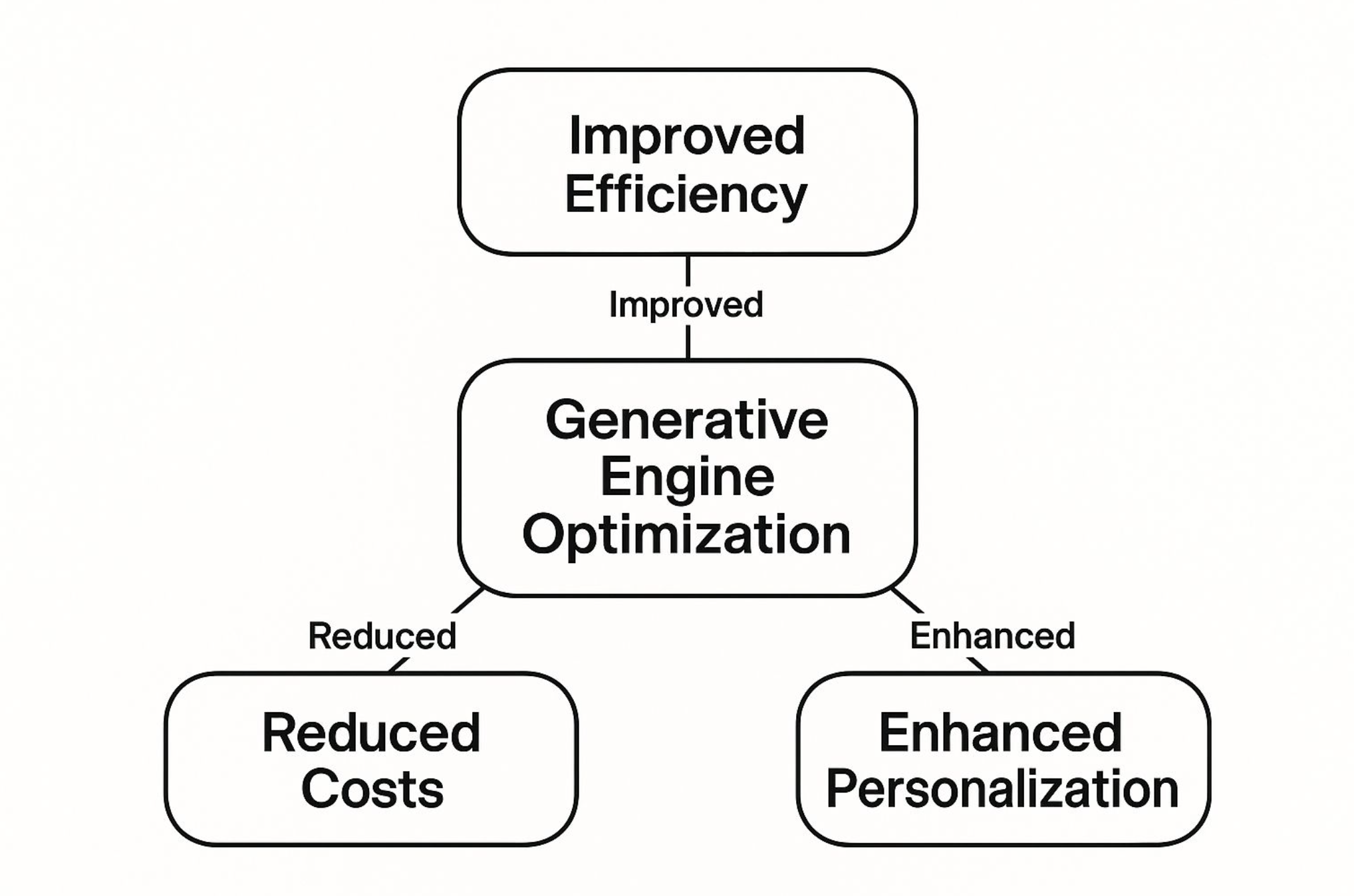Understanding Generative Engine Optimization Fundamentals

Generative Engine Optimization for AI Search
Imagine having a super-smart research assistant who can instantly access and process the entire internet. That's the core idea behind Generative Engine Optimization (GEO). It's all about preparing your content so AI systems recognize its value and trust it when answering user questions.
Traditional search engines work by matching keywords and showing users a list of links. Generative engines, like ChatGPT, Claude, and Perplexity, take things much further. They actually read, understand, and synthesize information to provide conversational answers.
This represents a huge change in how people find information online. Instead of simply searching for "best hiking boots," a user might ask an AI "what are the best hiking boots for the Bavarian Alps in October?" and get a detailed, specific response drawn from multiple online sources.
Adapting to the AI-Driven Search Landscape
This shift requires a new approach to content creation. We need to think about how these AI systems assess quality, judge trustworthiness, and choose which information to include in their responses. Keyword density isn't enough anymore. Now, factors like factual accuracy, clear structure, and authoritative tone are paramount.
This means creating content that's easy for both humans and AI to understand. The goal is to provide valuable and trustworthy information. A great resource for getting started is GEO 101: Generative Engine Optimization Basics.
Recent studies have shown just how much GEO can improve your content’s visibility. In 2024, research indicated that optimizing content for AI-driven search engines could boost visibility by up to 40% across various queries and topics.
While German-specific (DE) data is still somewhat limited, the research methods used, including a 10,000-query benchmark (GEO-bench), apply to European markets, including Germany. You can find more details here.
This fundamental change in how we find information online presents both exciting opportunities and new challenges. Businesses that actively embrace GEO will be best equipped to connect with their target audience in this new age of AI-powered search. As AI continues to advance, understanding these core principles will be crucial for online success and engagement.
How AI Search Engines Actually Process Your Content

How AI Search Engines Actually Process Your Content
This infographic illustrates the core advantages of generative engine optimization (GEO): better efficiency, lower costs, and more personalized experiences. These benefits come directly from how AI search engines interact with your content. It’s a much more sophisticated process than simply matching keywords, like traditional search engines. GEO offers a way to achieve these important business goals.
Think of generative engines as having a conversation with your content. Instead of just scanning for keywords, these systems delve deeper.
They look at the context of your words, assess signals of authority, and even cross-check information from multiple sources. The result? A coherent, conversational response, often blending insights from various perspectives.
Let's say someone asks an AI, "What's the best way to optimize my website for generative search in Germany?" The engine doesn't just return a list of links.
It considers content from recognized German SEO experts, analyzes best practices discussed in industry blogs like SEO Pace, and synthesizes a direct answer. For a deeper dive, check out our article on AI's Impact on SEO.
Understanding Retrieval-Augmented Generation
This process relies on retrieval-augmented generation (RAG), a key difference from traditional search.
First, the AI pulls relevant information from its massive database. Then, it uses this information to create a unique, customized answer. This two-step process ensures responses are both informative and specific to the user's question.
Let's compare this to traditional search engines. They simply index and retrieve web pages based on keyword matches. With GEO, however, your content becomes part of a larger conversation.
This means structuring your content logically, using clear headings, and providing factual information is now more critical than ever. By understanding these underlying mechanics, you can craft content that AI engines are more likely to reference and recommend, boosting your visibility in this new search landscape.
To further clarify the differences, let's look at a comparison table:
The following table highlights the key distinctions between traditional SEO and GEO, focusing on ranking factors, content requirements, and success metrics. Understanding these differences is crucial for adapting your content strategy for the evolving search environment.
Traditional SEO vs. Generative Engine Optimization Comparison:
Aspect | Traditional SEO | Generative Engine Optimization | Impact on Strategy |
Ranking Factors | Keywords, backlinks, page speed, mobile-friendliness | Content authority, structured data, semantic relevance, user engagement | Shift from keyword focus to topical authority and user experience. |
Content Requirements | Keyword-optimized content, meta descriptions, title tags | Comprehensive, factual content, clear headings, structured data markup, conversational tone | Prioritize content quality and structure over keyword density. |
Success Metrics | Click-through rate (CTR), keyword rankings, organic traffic | Citation count, impression share in AI summaries, engagement with AI-generated responses | Track visibility and engagement within AI platforms, not just search engine rankings. |
As you can see, GEO represents a significant shift in how we approach content creation and optimization. While traditional SEO focuses on optimizing for search engine algorithms, GEO focuses on optimizing for AI understanding and user engagement within the context of AI-generated responses. This necessitates a more holistic approach to content strategy, prioritizing quality, structure, and authority.
Why The Search Landscape Is Changing Forever

Why The Search Landscape Is Changing Forever
We're witnessing a fundamental shift in how people search for information online, a change as significant as the arrival of Google itself. Instead of simply wanting a list of links, users now expect direct answers to their questions. This evolving user behavior is driving the rapid adoption of AI-powered search tools across individuals and businesses alike.
This means the familiar patterns of search engine traffic are transforming. Think about it: instead of typing "Italian restaurants Berlin" into a search bar, a user might ask an AI, "Recommend authentic Italian restaurants near Brandenburg Gate."
This shift from keywords to conversational queries has profound implications for businesses. Understanding this new search landscape is no longer a luxury, but a necessity for staying competitive.
The Impact on User Behavior and Business
Generative engines are not just changing how we search; they're also influencing our buying decisions. Imagine someone asking, "Which electric car is best for families in Germany?" The AI could analyze countless reviews, safety ratings, and pricing data to offer a personalized recommendation, directly impacting which car brands even make it onto the user's radar. This targeted, AI-driven approach is a game-changer for marketers.
The shift towards AI-powered search is gaining momentum across Europe, particularly in Germany (DE). Experts predict a 25% decrease in traditional search engine traffic by 2026. This mirrors similar trends observed in the US and globally, with the German market closely following these patterns, as highlighted in recent industry reports. Discover more insights here.
Early adopters of generative engine optimization (GEO) are already experiencing the advantages. They're strategically positioning their content as authoritative sources within AI platforms, capturing a growing share of user attention. As AI search becomes the primary way people access information, the opportunities for those who adapt are immense.
Failing to adapt to this shift could mean losing visibility and, ultimately, losing customers.
Battle-Tested Strategies That Drive Real Results
Let's shift gears from theory to practical application and explore some proven techniques in Generative Engine Optimization (GEO). Think of GEO as a three-legged stool: it needs authoritative credibility, structured information, and natural contextual relevance to stand strong. These elements need to resonate with both human readers and AI systems.
Building Credibility and Trust
One effective strategy is weaving in credible statistics, expert insights, and verifiable facts – not as clunky add-ons, but as integral parts of your content that enhance the narrative. Imagine you're discussing the growth of AI search in Germany. Instead of simply stating its importance, picture providing a concrete statistic about the projected increase in AI search usage among German consumers. This data-driven approach adds weight to your argument and establishes you as a knowledgeable source.
Another way to build trust is by linking to authoritative websites within the DE region, like established German research institutions or well-regarded industry publications. Referencing recognized experts in the German digital marketing field also signals trustworthiness to both AI and human readers. For a deeper dive into the changing search landscape, check out our article: AI vs. Google.
Structuring Content for AI Comprehension
AI thrives on structure. Think of it as a highly efficient librarian that loves well-organized shelves. Specific formatting techniques make your content easier for AI to process and understand. Clear headings (H2, H3, etc.) act like labels on those shelves, helping AI quickly grasp the main topics and subtopics. Bullet points and numbered lists are like neatly stacked books, breaking down complex information into digestible chunks, making it simpler for AI to extract key takeaways.
Tables are like detailed catalogs, providing a structured format that AI can easily parse. For example, a table comparing different generative AI platforms and their features would be valuable for both human users and AI. This structured approach not only improves content clarity but also increases the likelihood of your information being featured in AI-generated responses.
Maintaining Contextual Relevance
While structuring content for AI is important, remember that we're ultimately writing for humans. GEO isn’t about keyword stuffing or writing robotic text. It's about crafting content that resonates with your target audience while also being easily understood by AI.
This means using natural language, incorporating relevant examples, and focusing on providing valuable information. Imagine how a human expert would explain a complex topic to a colleague – that conversational approach is key to balancing AI optimization with human engagement.
To help you visualize how these strategies come together, let's look at a practical framework:
To help visualize putting these strategies into action, let's look at a framework:
GEO Strategy Implementation Framework A comprehensive framework showing specific GEO tactics, implementation methods, and expected outcomes for different content types
Strategy | Implementation Method | Content Type | Expected Impact | Time to Results |
Building Credibility | Integrating credible statistics and expert insights | Blog posts, articles, white papers | Increased trust and authority | Medium to Long Term |
Building Credibility | Linking to authoritative websites | All content types | Enhanced credibility | Short to Medium Term |
Structuring Content | Using clear headings (H2, H3, etc.) | All content types | Improved AI comprehension | Short Term |
Structuring Content | Utilizing bullet points and numbered lists | All content types | Enhanced readability and AI parsing | Short Term |
Structuring Content | Presenting data in tables | Data-heavy content, comparisons | Improved data clarity and AI processing | Short Term |
Maintaining Contextual Relevance | Using natural language and relevant examples | All content types | Increased user engagement and AI understanding | Medium to Long Term |
Maintaining Contextual Relevance | Focusing on providing valuable information | All content types | Higher user satisfaction and potential for AI citations | Medium to Long Term |
This framework illustrates how different GEO tactics can be applied across various content types to achieve specific outcomes. While some tactics offer immediate benefits, others, like building credibility, require a longer-term approach.
By adhering to these core principles–credibility, structure, and relevance–you create content that earns citations, engages readers, and establishes you as an authority in your field. This holistic approach to content creation will become increasingly important as AI continues to shape the future of search.
Measuring Success With Next-Generation Metrics

Measuring Success With Next-Generation Metrics
Traditional website analytics are like trying to gauge a restaurant's popularity solely by counting passersby. You miss the vital piece: how many actually step inside and enjoy the meal. Similarly, clicks and bounce rate don't fully capture how people interact with your content in the age of AI-powered search. Forward-thinking organizations are developing new ways to measure this engagement.
Key Metrics for the Age of AI
These new metrics center around how generative engines use your content and how users engage with the AI's responses.
Citation frequency, for example, tracks how often your content is referenced by AI platforms. Think of it like counting recommendations from food bloggers—a good sign your restaurant is making an impact. This metric helps you understand your content's position within the broader AI ecosystem.
Another vital metric is the quality of representation in AI responses. This digs deeper than mere mentions. It examines how accurately and positively your content is summarized. Does the AI capture your core message, or is your brand misrepresented? Are the positive aspects highlighted? This ensures your brand message remains consistent and impactful within AI-generated content.
Share of voice within AI answers is also crucial. Imagine ten food bloggers recommending Italian restaurants, but only one mentions yours. Getting a mention is good, but grabbing a larger share of the AI-generated recommendations is better. This reflects your content's prominence within specific topics, giving you insight into your competitive landscape in the AI search world.
Tracking and Monitoring GEO Performance
The rise of Generative Engine Optimization (GEO) has led to the adoption of specific Key Performance Indicators (KPIs). Examples include AI-Generated Visibility Ratio (AIGVR), Click Engagement Rate (CER), and Semantic Relevance Score (SRS). These metrics reflect how user behavior is changing as people increasingly rely on AI for information. You can learn more about these emerging KPIs here. These measurements allow businesses to precisely track their effectiveness in connecting with their audiences through AI-driven platforms.
Beyond these, organizations are finding new ways to track brand mentions, expert positioning, and thought leadership within AI responses. New tools are emerging to monitor how often your brand is linked to specific industry topics and whether AI considers your content authoritative.
By combining these new metrics with traditional analytics, you create a complete dashboard. This gives you a true picture of your GEO efforts, enabling data-driven decisions, optimized content strategies, and a stronger presence in the evolving search landscape. This approach helps you continually refine your content’s performance within the AI-driven world.
Real Success Stories From The Front Lines
The best way to grasp the power of Generative Engine Optimization (GEO) is to see how it works in the real world. Let's dive into some compelling case studies where businesses have seen impressive results using GEO. These examples span different industries, showing just how versatile this approach can be.
E-Commerce Success With AI Recommendations
Picture an online retailer in Germany specializing in outdoor gear. They were struggling with declining visibility in traditional search results. However, by adopting GEO, they significantly improved how their products showed up in AI-powered shopping recommendations.
Their strategy? They focused on creating rich, detailed product descriptions packed with structured data. They highlighted key features like waterproof ratings and temperature ranges. This structured approach made it easy for AI shopping assistants to recommend their products when users asked questions like, "What's the best sleeping bag for camping in the Black Forest in November?"
The result? A 30% increase in product clicks from AI-driven recommendations in just six months.
B2B Thought Leadership In Generative Responses
Let's look at another example: a German B2B software company. They wanted to establish themselves as thought leaders in AI-powered customer service.
By creating in-depth content on topics like chatbot development and conversational AI, they became a go-to resource for information within generative responses. When users asked AI platforms about best practices in AI customer service, this company's content frequently popped up in the summaries.
This resulted in a 20% rise in website traffic from AI-driven search within a year, along with a noticeable boost in leads.
Learning From Both Success and Failure
Not every GEO implementation is a smooth ride. A German travel agency tried to optimize their website for generic keywords like "best vacation destinations." Their approach lacked the specific, context-rich content that AI thrives on.
As a result, they saw minimal improvement in visibility within AI-powered travel recommendations. This underscores the importance of focusing on specific user needs and offering detailed, relevant information.
Adapting Strategies For Your Own Context
These case studies demonstrate that GEO success relies on understanding how different content approaches perform across various AI platforms. Some platforms prioritize structured data, while others emphasize contextual relevance. By analyzing these differences, businesses can tailor their content strategy for the best results.
These real-world examples give us practical insights into realistic improvement timelines. While some businesses see quick wins, others experience more gradual growth. The key takeaway? Consistency and ongoing optimization are crucial for long-term success in generative search.
By learning from both wins and setbacks, companies can adapt and refine their approach, ensuring their content resonates effectively within the evolving world of AI-powered search. This adaptability is key to maximizing visibility and engagement in the future of search.
Your Strategic Roadmap For AI Search Dominance
Imagine typing a question into a search engine and getting a direct, conversational answer, pulling together insights from multiple sources. That's the power of generative AI search engines like Perplexity AI.
The takeaway? Optimizing for simple keywords isn't enough anymore. We need to think about how our content can directly answer complex questions and become a trusted source for these AI platforms.
Building Your GEO Foundation
Think of Generative Engine Optimization (GEO) like building a strong foundation for a house. It starts with a content audit. Review your existing content and ask yourself: If an AI were reading this, would it understand it? Is it factual, well-structured, and easy to digest? Does it answer the kinds of questions your target audience might ask an AI assistant? This initial assessment helps you spot areas for improvement.
Next, focus on creating authoritative content. Imagine you're presenting a case in court – you need strong evidence. Incorporate credible statistics, research findings, and insights from respected experts in your field. For businesses in Germany, this might mean referencing studies from well-regarded German universities or citing opinions from leading figures in the German digital marketing world. This builds your reputation within the AI ecosystem. As more businesses and publishers in Germany recognize the value of GEO, the market is projected to double between 2024 and 2026, outpacing traditional SEO growth. You can learn more about this trend here.
Advanced Optimization Techniques
Once you have a solid foundation, you can start adding the finer details. Think of this stage as furnishing and decorating your house. Implement structured data markup. This is like adding labels to your furniture so the AI can easily identify what everything is. Also, experiment with different content formats—like tables and lists—to present information in a way that's both user-friendly and easy for AI to understand. These strategies will make your content stand out in AI search results.
Staying Ahead of the Curve
The world of AI is constantly changing, like the weather. New platforms pop up, algorithms are updated, and user expectations shift. Stay up-to-date by following industry blogs, attending conferences, and connecting with the GEO community. This continuous learning is like checking the weather forecast – it helps you adapt and stay ahead of the curve in the ever-evolving world of AI search.
Ready to harness the potential of AI search for your business? SEOpace helps businesses to Get Leads from ChatGPT by tracking and improving brand visibility in AI-driven search. Visit the site to learn more and join the waitlist for exclusive access.

Peter Frank
GEO Strategist